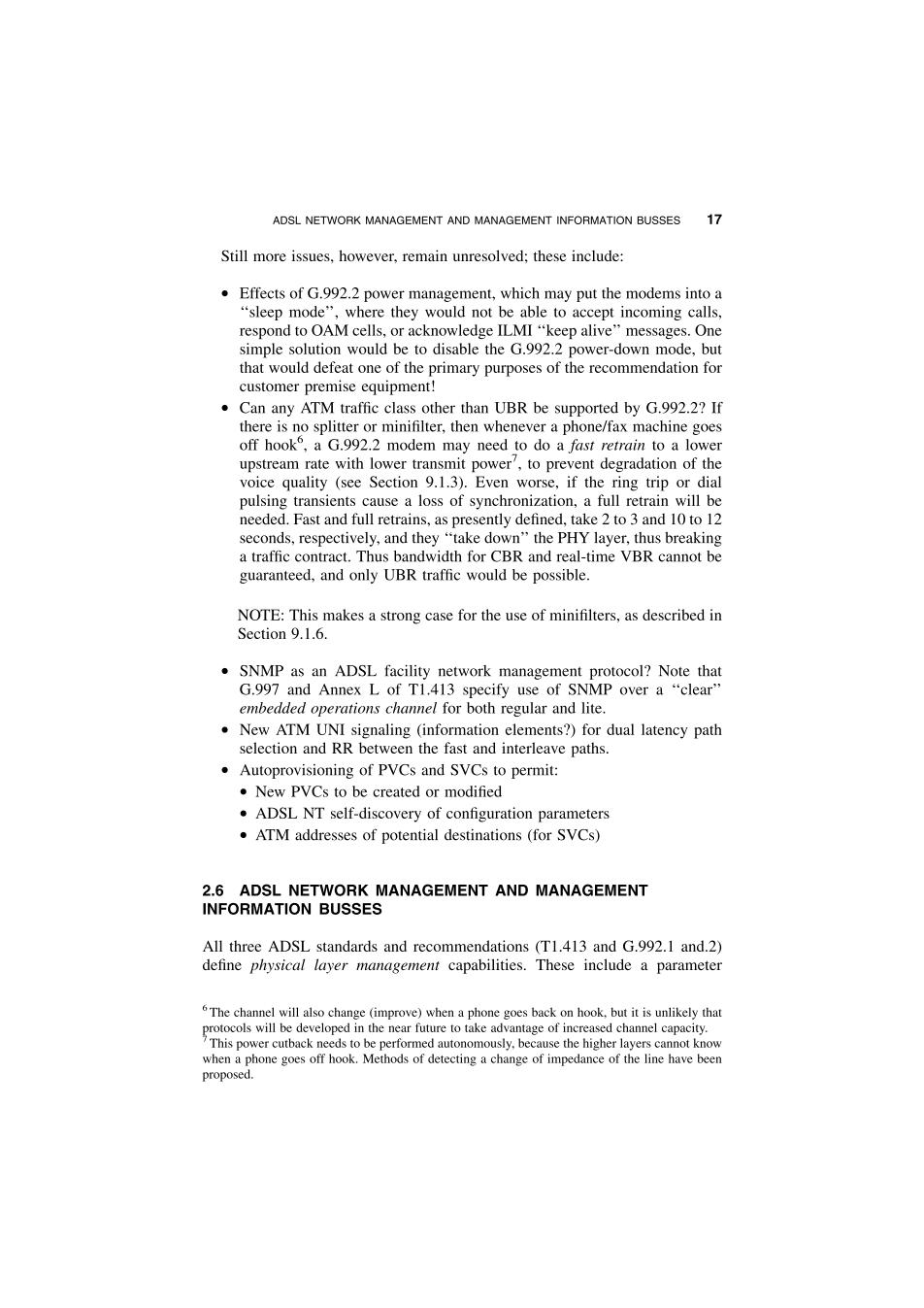正在加载图片...

ADSL NETWORK MANAGEMENT AND MANAGEMENT INFORMATION BUSSES 公 Still more issues.however.remain unresolved:these include: Effects of G.992.2 power management,which may put the modems into a "sleep mode",where they would not be able to accept incoming calls, respond to OAM cells,or acknowledge ILMI "keep alive"messages.One simple solution would be to disable the G.992.2 power-down mode,but that would defeat one of the primary purposes of the recommendation for customer premise equipment! Can any ATM traffic class other than UBR be supported by G.992.2?If there is no splitter or minifilter,then whenever a phone/fax machine goes off hook,a G.992.2 modem may need to do a fast retrain to a lower upstream rate with lower transmit power',to prevent degradation of the voice quality (see Section 9.1.3).Even worse,if the ring trip or dial pulsing transients cause a loss of synchronization,a full retrain will be needed.Fast and full retrains,as presently defined,take 2 to 3 and 10 to 12 seconds,respectively,and they "take down"the PHY layer,thus breaking a traffic contract.Thus bandwidth for CBR and real-time VBR cannot be guaranteed,and only UBR traffic would be possible NOTE:This makes a strong case for the use of minifilters,as described in Section 9.1.6. SNMP as an ADSL facility network management protocol?Note that G.997 and Annex L of T1.413 specify use of SNMP over a "clear" embedded operations channel for both regular and lite. New ATM UNI signaling (information elements?)for dual latency path selection and RR between the fast and interleave paths. Autoprovisioning of PVCs and SVCs to permit: New PVCs to be created or modified ADSL NT self-discovery of configuration parameters ATM addresses of potential destinations (for SVCs) 2.6 ADSL NETWORK MANAGEMENT AND MANAGEMENT INFORMATION BUSSES All three ADSL standards and recommendations (T1.413 and G.992.1 and.2) define physical layer management capabilities.These include a parameter 6The channel will also change (improve)when a phone goes back on hook,but it is unlikely that protocols will be developed in the near future to take advantage of increased channel capacity. This power cutback needs to be performed autonomously,because the higher layers cannot know when a phone goes off hook.Methods of detecting a change of impedance of the line have been proposed.
!!
"#$
%
&'$& %
"
! !
(
!
)
* +
#,$ -
./0!
!
1&
-
23
%4
56789:896;<
=
)
> ?@A
B
! C
-
%@?D?
%
EFG
!%
-,
!
+/0(H/0!
./0- !
! I",,
%
-
! ?4 I$E #J'
%
1I
=#3',?K?@
I$E :LM:NN:NOP:968;O<7QR6<<:S!
I #,$ .I&
> 1A
00!
#
EH+ H+
I EH+ !- #J'I, (
-
#,$
>H+ A TUV WXYZ[\]^_`abW[Wc\b\[]W[X bW[Wc\b\[] d[e_`bW]d_[ fgYY\Y #
#J' >,?K?@?A -PRh7;Q6SS6h:9L6<6i:L:<8
! ,
4,
>
A
!%
%
! %
!
%
=,
!% !
!
%
%$
!
jklmnopqrstujnjvouonpjnkujnjvouonpwnxrsujpwrnyzllol {|��������������������������������������������������������������������������������������������������������������������������������������������������������������������������������������������������������������������������